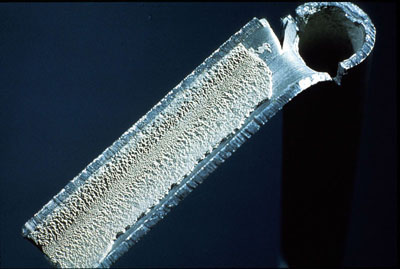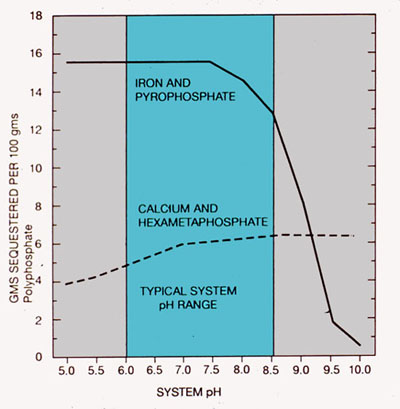Cooling systems that use a water's cooling capacity a single time are called once-through cooling systems. These systems use large volumes of water and typically discharge the once-through water directly to waste. Large volumes of water are necessary for even the smallest once-through systems; therefore, a plentiful water supply at a suitably low temperature is needed.
Because of the large volumes involved, once-through cooling systems often use water from rivers, lakes, or (occasionally) well networks. The only external treatment generally applied to a once-through system is mechanical screening to protect downstream equipment from serious damage due to foreign material intrusion. Evaporation is negligible, so no significant change in water chemistry occurs.
Once-through cooling water systems are identified by various names. For example, in the paper industry, most mills refer to their once-through cooling water as "mill supply." The power industry often refers to a once-through cooling network as the "service water" system. The chemical and hydrocarbon processing industries typically use the descriptive "once-through" terminology for their systems. Whatever the name, once-through systems present unique challenges for water treatment.
Problems encountered in once-through cooling systems can be grouped into three general categories:
- corrosion
- scale or other deposition
- biological fouling
Each of these problems is manifested in a particular manner in a once-through cooling system. Whatever the problem, mechanical and chemical solutions can be prescribed to minimize the consequences.
Corrosion can be defined as the wastage or loss of base metal in a system. Various types of corrosion can occur in once-through systems. However, in all cases, base metal loss is encountered and corrosion products enter the bulk water stream as troublesome suspended solids. In addition to the detrimental impact of suspended solids, serious process contamination and/or discharge problems can result from active corrosion.
Corrosion of ferrous metal piping results in the formation of iron oxide products many times the volume of the metal loss from the pipe wall. The accumulation of corrosion products, or tuberculation, on the pipe surface reduces the carrying capacity of lines and requires expensive mechanical or chemical cleaning. Also, the loss in head caused by tuberculation requires increased pump pressures and consequently higher pumping costs.
Deposits consist of two general types:
- crystalline inorganic deposits (when solubility limits are exceeded)
- sludge (when suspended solids settle)
The deposits insulate the metal surface from the cooling water, restricting heat transfer. Under-deposit corrosion can also occur. If the deposit formation is severe, hydraulic restrictions to flow may further impact the cooling system's ability to carry heat away from the process.
Biological concerns can be categorized as either microbiological or macrobiological. The proliferation of biological organisms in a cooling system results in many of the same problems caused by corrosion. Significant microbiological growth causes equipment fouling, heat transfer impediment, microbiologically induced corrosion (MIC), and possible flow restrictions. The infestation of U.S. fresh water with Asiatic clams and, more recently, zebra mussels has increased the emphasis on macrobiological control, because these organisms can completely plug a system in one growth season.
The most prevalent mechanism for the corrosion of steel in once-through cooling systems is an electrochemical process much like that which takes place in a common automobile battery. Electron flow is from anode to cathode, and metal loss occurs at the anode. The control of this corrosion requires that the electron flow be greatly reduced or stopped, short-circuiting the battery. In untreated once-through cooling systems, the metal loss may reach 100 mils (0.1 in.) per year. Treatment typically reduces the corrosion to 10 mils (0.01 in.) or less per year.
In addition to metal loss, deposit problems are caused by corrosion product accumulation in a heat exchanger tube exposed to an untreated stream of cooling water.
The large quantities of corrosion products produced at high corrosion rates can seriously impede heat transfer and reduce flow. Consequently, the effectiveness of the corrosion control program has a large impact on the quantity of deposit that accumulates in the once-through system.
The weight and volume of corrosion products produced as a function of corrosion rate and pipe size.
Corrosion Control Chemicals
Polyphosphates and zinc, used in combination or separately, are the corrosion inhibitors most commonly employed in once-through systems. Other inhibitors, such as silicates and molybdates, may be employed for special circumstances. Usually, due to the large water volumes involved, it is not economically practical to feed enough corrosion inhibitor to stifle corrosion completely. In any treatment approach, the application rate is set to produce an acceptable level of corrosion. This level of treatment is often termed "threshold."
Polyphosphates (e.g., sodium tripolyphosphate, sodium hexametaphosphate, and potassium pyrophosphate) are molecularly dehydrated forms of orthophosphate. These special phosphates possess surface-active and sequestering capabilities that make them particularly effective in controlling scale formation and minimizing tuberculation.
Polyphosphates are widely used in treating once-through industrial systems, municipal systems, and potable drinking water systems. The polyphosphates effectively reduce tuberculation in distribution lines and minimize red water caused by high iron levels in both potable and industrial systems. Effective results have been achieved with treatment levels as low as 1 ppm. Corrosion protection at this low phosphate level can be improved with the addition of a small amount of zinc (as little as 0.25 ppm). The use of zinc and polyphosphates protects the system steel from both general corrosion and pitting, while reducing the red water conditions prevalent when excessive corrosion products enter the system. Polyphos-phate and zinc treatment levels are not set to stifle corrosion completely, but to provide corrosion rates of approximately 10 mils (0.01 in.) per year or less.
Silicates and molybdates are specialty inhibitors that typically do not fit the needs of once-through cooling systems. Compared to the polyphosphates, high levels of silicates and molybdates are required to control steel corrosion. A 100 ppm silicate level provides corrosion protection approximately equal to 2 ppm of polyphosphate. The cost of molybdate treatment precludes its use in most industrial once-through cooling systems.
The control of scale formation on heat transfer surfaces is necessary for the efficient operation of a once-through cooling system. The use of polyphosphates or organic polymers can greatly reduce the deposit potential of system streams. In addition to impeding heat transfer, deposits can alter flow characteristics, induce under-deposit corrosion, increase power consumption for pumping, and release corrosion products to contaminate process streams exposed to the once-through water.
Common scales found in once-through systems are hardness salts, such as calcium and magnesium, combined with anions, such as carbonate, sulfate, and silica. Manganese and barium are less common but equally troublesome scale formers found in certain areas of the country. Corrosion products such as iron oxide also can be significant contributors to scale formation. Mud and silt also add to deposit formation in once-through systems.
The effect of temperature on the solubility of calcium carbonate.
As temperature increases, the solubility decreases and scale formation results.
Scale control may be achieved in many ways. Specialty chemicals are usually employed to minimize calcium carbonate scale. Calcium reduction through softening is not economically practical in once-through systems due to the large quantity of water processed.
When specialty chemicals are used, the deposit control agent must prevent crystal growth and scale formation by permitting scale-forming salts to exist in an over-saturated condition without precipitation. Commonly used agents include polyphosphates, organic phosphates, and organic polymers. Treatment levels are based on system conditions and vary from less than 1 ppm to as much as 5 ppm.
Iron deposition is another special problem in once-through systems. The iron may enter the system from wells or surface water, or as a result of system corrosion. In any case, a deposit control agent can be used to control deposition. Polyphosphates, organic phosphates, surface-active compounds, and polyelectrolytes are used for this purpose. Treatment levelsvary from less than 1 ppm to 5 ppm active compound. At even higher levels, intermittent treatment has been used to clean up old iron deposition.
The ability of hexametaphosphate to sequester calcium, thereby preventing scale formation, and the ability of pyrophosphate to sequester iron and minimize deposition, as well as knowledge of the predominant depositing species, are important factors in the selection of a particular deposit control program.
The use of polyelectrolytes for deposit control in once-through systems has become more common in recent years. The power industry has pioneered the use of very low treatment levels of proprietary polymers for specific deposit control problems. Polymers in the acrylate and acrylamide families have been proven effective in large-volume once-through systems even at treatment levels measured in the parts per billion range.
Deposits formed as a result of microbiological activity are particularly troublesome in once-through systems. The deposits formed by living organisms restrict heat transfer and often lead to severe under-deposit corrosion. Also, the organisms serve as a matrix binder for inorganic species that increase deposit volume and tenacity. Further, severe macrobiological fouling can essentially stop water flow through heat exchange and process equipment in a short period of time.
Biological Fouling Control
Oxidizing agents such as chlorine and bromine have been used for microbiological control in once-through cooling systems. The frequency, duration, and treatment level for the oxidizing agent vary according to the nature of the system and the water source. Current and future environmental restrictions must be considered in the design of a microbiological control program for once-through systems.
Macrobiological control, particularly the control of mollusks found in fresh waters in the United States, is a serious problem in many systems. Whenever fresh water is used for once-through cooling, the threat of Asiatic clam and/or zebra mussel infestation exists. Proprietary chemicals are available for control of these organisms. Application rate and frequency are system-dependent.
Figure 30-1. Classic steel corrosion cell.

Figure 30-2. Deposition of corrosion products in a once-through system.

Figure 30-3. Iron corrosion product from corrosion.

Figure 30-4. Calcium carbonate solubility vs. temperature.

Figure 30-5. Theoretically, calcium carbonate scale can provide a protective film.

Figure 30-6. The sequestration of calcium by hexametaphosphate and iron by pyrophosphate.

